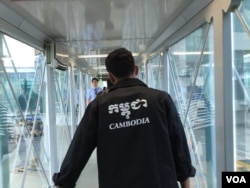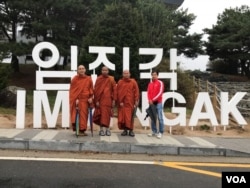For Leng Chanry, one of thousands of Cambodians working for South Korean companies near Suwon town, the clean and relatively comfortable conditions in his rubber factory are a far cry from the arduous drudgery he experienced in his homeland.
The 34 year old was one of several expatriate Cambodian laborers VOA Khmer spoke to in April, all of whom spoke highly of the treatment the received from their Korean managers.
“It’s a huge difference, obviously,” says Chanry. A Pursat province native who earns about $2,000 per month at the factory, 20 times what he would make in Cambodia doing a similar job.
He says there has been no mistreatment of workers at the factory by management and is provided lodgings and meals on top of his salary.
“I want more Cambodian workers to come and also I want Cambodia to create good jobs with high salaries, like in Korea,” he says.
His factory supplies rubber to car manufacturers and other companies locally, employing only a small number of staff -- two Cambodians and two Koreans. But the firm is successful, recording about $700,000 in annual turnover.
At the factory, the workers are provided chairs and a table, refreshments and short breaks every two hours.
Cambodians working for factories in South Korea have also gained a reputation as hard workers willing to put in long hours to earn their keep and produce quality products.
Heo Jin Gu, the manager of the factory were Chanry works, said the company faces fierce competition from rival manufacturers.
“I have worked with other nationals, but Cambodians are better,” he says. “Chinese workers and others seem to work below the standard that I want and they are not gentle as well.”
At another nearby factory, which produces parts for air conditioners, Doo-Sung Lee also speaks highly of his Cambodian employees.
“Before, I also had Thai workers, Vietnamese workers and other nationalities worked here, but because I saw Cambodian workers working hard and doing better, I gradually stopped [using workers from other countries] and I only have Cambodian workers and Korean workers [now],” he said.
He adds that his factory pays similar wages to Cambodian migrant workers as it does the local staff, with minor deductions for accommodation, meals and bills -- a stance he says has improved productivity and quality control.
“There is competition, so we have to lower the prices but the quality is still higher than others. If we don’t do that, they will use other factories to produce the materials for them. So in order to produce and have more work to do, we have to make production prices cheaper and produce better quality products than our competitors,” Lee says.
Prim Phumy is busy working the machinery as he tells VOA Khmer that he used to be a teacher in Kratie province. He plans to use the money he has saved in South Korea to open a business when he returns home.
“Because I was a teacher, when I go back I will create a business like a training center to train languages that I know, or life skills,” he says. He wanted to return to Cambodia some time ago, he adds, but the manager persuaded him to stay on until a replacement can be found.
Cambodia has had diplomatic relations with South Korea since 1997 and has developed close ties through trade, investment, migration and diplomacy. Despite recent saber-rattling between the country’s northern neighbor and the United States, few workers are concerned about the possibility of conflict.
South Korea now hosts tens of thousands of Cambodian workers and several hundred students here on an exchange program sponsored by UNESCO.
Oul Sethavy, an elementary school teacher here as part of the program, said she was optimistic about improving the Cambodian education system following her visit to South Korea.
“We all came here to develop the education and exchange experience between South Korea and Cambodia,” she said.
The teachers noticed that Korean schools are better equipped, have fewer students per class, and have different teaching strategies to their Cambodian counterparts.
The teachers who spoke to VOA Khmer were in Suwon to attend Khmer new Year celebrations, along with migrant workers and monks.
Venerable Phouk Koeng of Ounalom temple said he was pleased to see young generations of Cambodians celebrating the festivities in South Korea.
“I see that the young generation, Cambodian workers, celebrate better here than in Cambodia... They don’t fight, stab each other, snatching water from each other. It may say something about the rule of law in South Korea,” he says.
Venerable Rin Saro, head of the Cambodian Buddhist Center in Korea, said the group was established to provide Cambodians a place to worship as they are unable to do so in their workplaces.
It also plays an important role as a temporary refuge for those in need, providing services such as Korean language translation.
“When they [workers] have problems they don’t know how to solve them. In Korea there are many centers, religious organizations to help, but when they have problems they don’t know how to tell the Korean owners,” he says.
“So when they try often the problems escalate and they can’t solve it, when, in fact, the solutions are simple.”
Yim Sinorn of the Cambodian Association of Migrant Workers in Korea, echoes the sentiment that the “language barrier” is a key issue facing Cambodian workers, especially when they fall ill.
“By law they cannot discriminate against workers because they are sick, they must take care of them. But Korean owners have to work fast to meet demand, so they don’t want the workers to take time off if they are not seriously sick,” he said.
Many workers also report trouble dealing with adjusting to the South Korean culture and bureaucratic challenges. However, they say that the embassy in Seoul can be helpful in this regard.
On a visit to a workers’ Khmer New Year celebration on April 16, Cambodia’s labor minister, Ith Sam Heng, encouraged attendees to keep up the hard work as they were acting as representatives of Cambodia in South Korea.
“Cambodia ranks number one of the best quality of workers [in South Korea]. So, please maintain it and in order to maintain this record, we need to work hard, follow the law, and rules properly,” he said.









